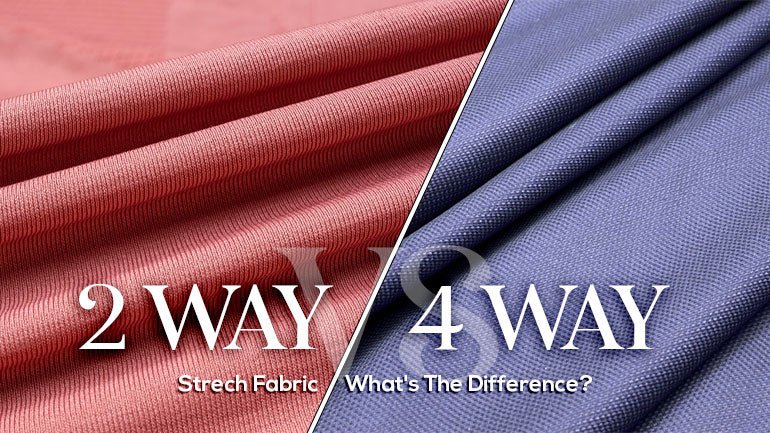In the world of fashion, fabric is everything. The right fabric can make or break a garment, which is why designers spend a considerable amount of time researching and selecting the perfect materials for their creations.
Choosing fabric for sewing projects, it can be easy to feel overwhelmed with all the different types and terminologies out there. Two of the most common phrases you might hear are 2 way stretch and 4 way stretch, but what do they actually mean?
Two of the most popular types of fabric used in clothing today are two-way and four-way stretch. While they may sound similar, there are significant differences between the two.
In terms of popularity, both two-way and four-way stretch fabrics are widely used in fashion today. Two-way stretch fabrics are popular in everyday clothing, such as pants, skirts, and dresses. They are also used in more formal clothing, including suits and blazers. Four-way stretch fabrics are popular in activewear, swimwear, and other athletic clothing. They are also used in fashion-forward clothing such as leggings and bodysuits.
Are you looking for 2 way vs 4 way fabric? Here we will dive into the difference between 2 way and 4 way stretch fabric, exploring the various factors 2-Way vs. 4-Way Stretch Fabric.
How Does Fabric Stretch?
Two-way and four-way stretch fabrics are commonly used in clothing and textile industries due to their unique properties that allow for comfortable and flexible wear. The way in which the fabric stretches depends on a few factors, including mechanical stretch, added stretch, and fabric content.
Mechanical stretch refers to the natural stretch that occurs in a fabric due to its construction. This can be achieved through the use of a knit or weave pattern that allows for some stretchiness in the fabric. Two-way stretch fabrics have mechanical stretch in only one direction, typically widthwise, while four-way stretch fabrics have mechanical stretch in both directions, both widthwise and lengthwise.
Added stretch refers to the use of synthetic fibers, such as spandex, or elastane, which are blended with natural fibers like cotton or wool to create a fabric that can stretch beyond its natural elasticity. This added stretch can provide more flexibility and comfort, as well as better shape retention, durability, and resistance to wrinkling.
The fabric content also plays a role in how the fabric stretches. For example, natural fibers like cotton, wool, and silk tend to have limited stretch, while synthetic fibers like polyester, nylon, and spandex can offer more stretch and recovery. Blends of these fibers can provide a balance of comfort, durability, and stretchiness.
Stretch Directions
Before delving into the differences between two way stretch and four way stretch fabric, it’s important to understand the different stretch directions.
One Directional Stretch: The term is used when the fabric is constructed using yarns that only stretch in a single direction. If a fabric is created using yarns which only stretch in one direction, it is referred to as a one-directional stretch. The material will only expand in the direction that the yarns were designed for stretching in. One-direction stretch fabric is more flexible or gives in one direction than it does in the other. This is why it's often referred to as 2-way stretch fabrics.
Two-Directional Stretch: If a fabric is constructed from yarns with stretchy properties in multiple directions, it's called having a four-way or two-way stretch. This kind of fabric can stretch in both crosswise and lengthwise directions. Two-directional stretch fabric usually has an identical amount of elasticity or gives in both directions.
Two Way Stretch Fabric
The stretch fabric can only stretch lengthwise or widthwise; however, it cannot stretch simultaneously in both directions simultaneously. The stretch typically occurs from selvage to selvage, the edges of the material formed to stop the fabric from unraveling. Two way stretch fabric is also known as one-way stretch or single-axis stretch. It is commonly used in garments where stretch is required in one direction only, such as stretch denim jeans or skirts and fitted blouses or dresses.
Four Way Stretch Fabric
Most people prefer the 4-way stretch fabric to make sportswear. It is able to stretch lengthwise and widthwise at the same time, which allows for more elasticity. The most well-known example of a four-way stretch cloth is the spandex. Using fabric that has 4-way stretch on athletic clothing allows the clothing to be shaped to fit your body and withstand greater strain and stress as you move. Similar to 2-way stretch fabrics, the easiest method to determine whether something is a 4-way stretch is to stretch the fabric lengthwise and widthwise. If it can stretch both ways without difficulty, it is a 4-way stretch fabric.
Get a deeper understanding of What is 4 Way Stretch Fabric.
2 Way vs. 4 Way Stretch Fabric
As we have discussed above, the main difference between 2-way and 4-way stretch fabric is the direction in which the fabric stretches. 2-way stretch fabric stretches in one direction only, while 4-way stretch fabric stretches in both directions, horizontally and vertically.
If you are creating activewear or sportswear that requires a high level of flexibility and movement, 4-way stretch fabric is the best option. On the other hand, if you are creating a dress or skirt that only requires a moderate amount of stretch, the 2-way stretch fabric may be more appropriate.
Table: Differences between 2-Way and 4-Way Stretch Fabric
|
Criteria |
2-Way Stretch Fabric |
4-Way Stretch Fabric |
|
Direction of Stretch |
Stretches in one direction only (either horizontally or vertically) |
Stretches in both directions (horizontally and vertically) |
|
Amount of Stretch |
Moderate amount of stretch |
High level of stretch |
|
Common Uses |
Dresses, skirts, pants |
Activewear, sportswear, clothing that requires high flexibility and movement |
In terms of care, both 2-way and 4-way stretch fabrics should be washed in cold water and hung to dry. Avoid using fabric softeners, as they can break down the spandex or elastane fibers over time.
How to Do a Stretch Test?
To check if a fabric has a one-directional or two-way stretch, you can do a simple stretch test. Cut a small section of fabric measuring at least 4 inches or 10 centimeters square and hold one edge of the fabric down while gently pulling the opposite edge away. If the fabric stretches in that direction, it has a one-directional or two-way stretch.
How Can You Tell if a Fabric is a 4-Way Stretch?
To determine if the fabric has a four-way stretch, repeat the test by pulling the fabric from top to bottom. If it stretches in this direction as well, then it has a four-way stretch. You can also determine the stretch percentage by calculating the percentage increase in the length of the fabric after stretching it out.
However, the amount of stretch can vary based on how far the fabric is stretched. For example, stretching a 4-inch piece of fabric to 4.4 inches equates to a 10% stretch, while stretching it to 6 inches means it has a 50% stretch. Similarly, a 4-inch fabric piece stretching to 8 inches means it has a 100% stretch.
Uncover all the secrets of How to Sew 4 Way Stretch Fabric.
Final words
Making use of both 2-way or 4-way stretch fabric for your own sewing projects is the best option to keep your family members nice and comfy. These fabrics are used for different clothing, such as shirts, pants, and skirts. Additionally, they are available in a variety of prints and colors to ensure that you and your family are always stylish.
If you are searching for stretch fabric, you can shop from Ice Fabrics. I hope that this article is able to provide clarity on the differences between 2-way and 4-way stretch fabrics.



